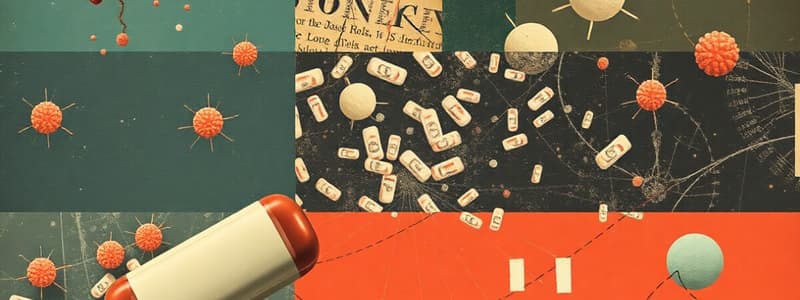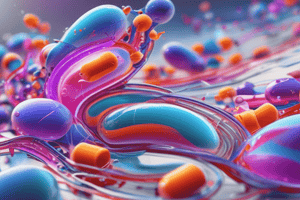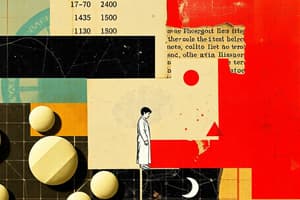Podcast
Questions and Answers
What is the term used to describe the maximum response achievable by a drug when all receptors are occupied?
What is the term used to describe the maximum response achievable by a drug when all receptors are occupied?
- Potency
- Affinity
- Efficacy
- Emax (correct)
Which factors primarily determine a drug's efficacy?
Which factors primarily determine a drug's efficacy?
- Patient's metabolism and age
- Dosage and frequency of administration
- Route of administration and formulation
- Number of drug-receptor complexes and intrinsic activity (correct)
Which of the following statements about full and partial agonists is true?
Which of the following statements about full and partial agonists is true?
- Both full and partial agonists cause zero response at 100% receptor occupancy.
- Full agonists exhibit a higher maximal efficacy than partial agonists. (correct)
- A partial agonist can achieve the same response as a full agonist.
- Partial agonists always have a higher binding affinity than full agonists.
What is the significance of the dissociation constant (Kd) in pharmacology?
What is the significance of the dissociation constant (Kd) in pharmacology?
Which drug has low efficacy based on sodium excretion as a measure?
Which drug has low efficacy based on sodium excretion as a measure?
Why is efficacy considered more clinically important than potency?
Why is efficacy considered more clinically important than potency?
How does selectivity play a role in drug action?
How does selectivity play a role in drug action?
What happens to the efficacy of an antagonist when it occupies 100% of the receptor sites?
What happens to the efficacy of an antagonist when it occupies 100% of the receptor sites?
What characterizes the selectivity of salbutamol as a bronchodilator?
What characterizes the selectivity of salbutamol as a bronchodilator?
How is receptor selectivity measured when investigating a drug's action?
How is receptor selectivity measured when investigating a drug's action?
What does intrinsic activity refer to in relation to a drug?
What does intrinsic activity refer to in relation to a drug?
What defines a full agonist?
What defines a full agonist?
What happens to the selectivity of a drug at extremely high doses?
What happens to the selectivity of a drug at extremely high doses?
Which of the following describes a partial agonist?
Which of the following describes a partial agonist?
What does having a high intrinsic activity indicate for a drug?
What does having a high intrinsic activity indicate for a drug?
What is the intrinsic activity of a drug classified as an antagonist?
What is the intrinsic activity of a drug classified as an antagonist?
What do irreversible and allosteric antagonists have in common?
What do irreversible and allosteric antagonists have in common?
In what way do competitive antagonists influence agonist potency?
In what way do competitive antagonists influence agonist potency?
How does an allosteric antagonist affect the Emax of an agonist?
How does an allosteric antagonist affect the Emax of an agonist?
Which type of antagonism involves acting on a completely separate receptor?
Which type of antagonism involves acting on a completely separate receptor?
Which example illustrates functional antagonism?
Which example illustrates functional antagonism?
What characterizes chemical antagonists?
What characterizes chemical antagonists?
What defines a quantal dose-response relationship?
What defines a quantal dose-response relationship?
Which drug is used as an example of a quantal dose-response relationship?
Which drug is used as an example of a quantal dose-response relationship?
What effect does phenylephrine have on α1-adrenoceptors?
What effect does phenylephrine have on α1-adrenoceptors?
What characterizes partial agonists in comparison to full agonists?
What characterizes partial agonists in comparison to full agonists?
How can partial agonists behave when both they and a full agonist are present?
How can partial agonists behave when both they and a full agonist are present?
What is constitutive activity in the context of receptor signaling?
What is constitutive activity in the context of receptor signaling?
What is the role of inverse agonists in receptor activity?
What is the role of inverse agonists in receptor activity?
How does aripiprazole function as a partial agonist at dopamine receptors?
How does aripiprazole function as a partial agonist at dopamine receptors?
What happens to vascular smooth muscle upon phenylephrine binding to α1-adrenoceptors?
What happens to vascular smooth muscle upon phenylephrine binding to α1-adrenoceptors?
How do partial agonists help stabilize receptor activity?
How do partial agonists help stabilize receptor activity?
What is defined as a positive response in terms of diastolic blood pressure?
What is defined as a positive response in terms of diastolic blood pressure?
What does the ED50 represent in quantal dose–response curves?
What does the ED50 represent in quantal dose–response curves?
How is the therapeutic index (TI) calculated?
How is the therapeutic index (TI) calculated?
What does a larger therapeutic index (TI) indicate about a drug’s safety?
What does a larger therapeutic index (TI) indicate about a drug’s safety?
What is the therapeutic window?
What is the therapeutic window?
Which statement is true regarding drugs with low therapeutic indices?
Which statement is true regarding drugs with low therapeutic indices?
What occurs as the dose of warfarin increases according to its therapeutic index?
What occurs as the dose of warfarin increases according to its therapeutic index?
How does penicillin illustrate the concept of a large therapeutic index?
How does penicillin illustrate the concept of a large therapeutic index?
Flashcards are hidden until you start studying
Study Notes
Efficacy
- Definition: the extent to which a drug elicits a response when it interacts with a receptor.
- Factors: Efficacy depends on the number of drug-receptor complexes formed and the drug's intrinsic activity (ability to activate the receptor and cause a cellular response).
- Maximal Efficacy (Emax): Assumes all receptors are occupied by the drug. No further increase in response with higher concentrations.
- Clinical Importance: A more efficacious drug yields greater therapeutic benefit, outweighing potency.
- Examples: Amiloride (low efficacy) has 5% sodium excretion, while Frusemide (high efficacy) has 25% sodium excretion.
Graded Dose-Binding Relationship and Binding Affinity
- Dose-Binding Graph: Similar to the dose-response curve, it measures the percentage of receptors bound by a drug versus the drug concentration logarithm.
- Dissociation Constant (Kd): Represents the drug concentration required to bind 50% of the receptor sites. It indicates the drug's affinity for its binding site on the receptor.
- Affinity: A smaller Kd indicates a higher affinity.
- Bmax: If the number of binding sites on each receptor molecule is known, Bmax can determine the total number of receptors in the system.
Selectivity
- Definition: Drugs can preferentially act on specific receptor types or subtypes. Quantifying selectivity is important.
- Example: Salbutamol (a bronchodilator), is 10 times more effective at stimulating β2-adrenoceptors in airway smooth muscle than β1-adrenoceptors in the heart.
- Investigation: Selectivity often involves measuring the drug's effects in vitro on different cells/tissues expressing only one specific receptor.
- Log Dose-Response Curves: The ratio of drug doses required to achieve a given response reflects selectivity.
Intrinsic Activity
- Definition: The ability of a bound drug to induce the conformational changes in the receptor required for signaling or response.
- Determines Receptor Activation (Agonist): Intrinsic activity determines whether a drug fully or partially activates receptors.
- High Affinity, Low Intrinsic Activity: A drug can bind with high affinity but have low intrinsic activity.
- Antagonists: Drugs with zero intrinsic activity are antagonists.
Agonists
- Full Agonists: Bind to a receptor and produce the maximal biological response, mimicking the endogenous ligand.
- Feature: Full agonists have an intrinsic activity of 1.
- Example: Phenylephrine is a full agonist at α1-adrenoceptors, producing the same Emax as norepinephrine (the endogenous ligand).
- Partial Agonists: Cannot produce the same Emax as a full agonist even with full receptor occupancy.
- Feature: Partial agonist intrinsic activity is greater than 0 but less than 1.
- Example: Aripiprazole (atypical antipsychotic) is a partial agonist at dopamine receptors.
- Inverse Agonists: Stabilize the inactive receptor form, decreasing the number of activated receptors.
- Constitutive Activity: Some receptors exhibit activity in the absence of a ligand, meaning a fraction of the receptor is always activated.
Antagonists
- Competitive Antagonists: Bind reversibly to the same site as the agonist, reducing agonist potency (increasing EC50).
- Noncompetitive Antagonists: Bind irreversibly to the receptor, reducing agonist efficacy (decreasing Emax).
- Allosteric Antagonists: Bind to a site other than the agonist-binding site (allosteric site), preventing receptor activation by the agonist.
- Example: Picrotoxin binds to the inside of the GABA-chloride channel, preventing chloride influx, hindering the receptor's activation by GABA.
- Functional Antagonism: An antagonist acts at a separate receptor, initiating effects opposite to the agonist's.
- Example: Epinephrine counteracts histamine-induced bronchoconstriction. (Epinephrine acts via β2-adrenoceptors causing bronchodilation while histamine acts via H1 receptors causing bronchoconstriction).
- Chemical Antagonists: Interact directly with the agonist to remove or prevent its binding.
- Examples:
- Dimercaprol: Chelator of lead and other toxic metals.
- Pralidoxime: Combines with organophosphate cholinesterase inhibitors.
Quantal Dose-Response Relationships
- Definition: Relates the drug dose to the proportion of a population responding to it.
- Transformed Graded Responses: A predetermined level of a graded response defines responders and non-responders.
- Applications: Used to determine doses for most-of-the-population response.
- ED50: The drug dose causing a therapeutic response in 50% of the population.
Therapeutic Index
- Definition: Ratio of the dose causing toxicity in 50% of the population (TD50) to the dose causing the desired effect in 50% of the population (ED50): TI = TD50/ED50.
- Safety Measure: A higher TI indicates a wider margin between effective and toxic drug doses.
- Therapeutic Window: Describes the dosage range between the minimum therapeutic concentration and the minimum toxic concentration.
- Low Therapeutic Index Drugs: Examples include warfarin (oral anticoagulant) and penicillin (antimicrobial).
- Interpretation: High TI values are generally preferred, but drugs with low TI are used for serious conditions where the risk of leaving the disease untreated outweighs the risk of side effects.
Studying That Suits You
Use AI to generate personalized quizzes and flashcards to suit your learning preferences.




